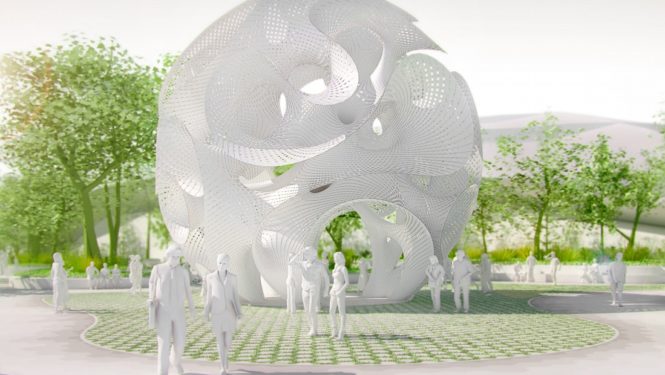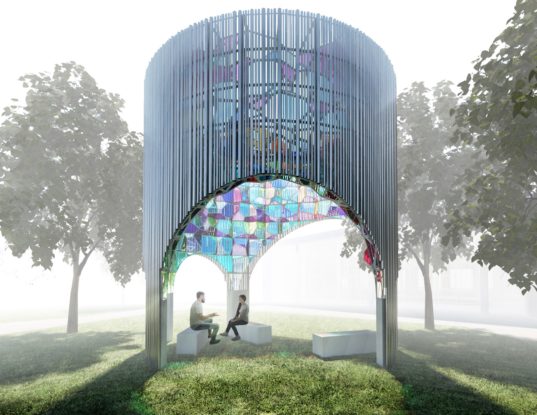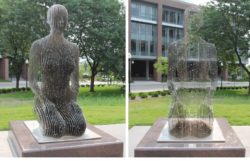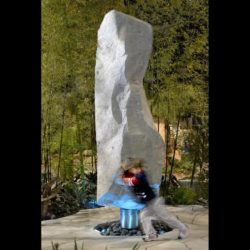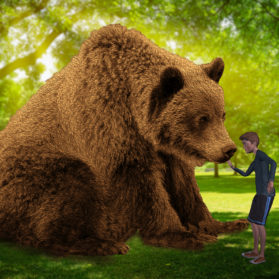Over the last two years, Burning Man Project’s Civic Arts team has had the opportunity to collaborate with Google to develop the plan for installing six art projects in the new public Charleston East Plaza in Mountain View, California. Our work involved a six-month community engagement process, an international call for artists, and an art selection and review process.
We are now pleased to announce the selection of six artworks and the deployment of $1.5 million to support six amazing artist teams as they bring these artworks to life. These are:
- Marc Fornes, THEVERYMANY, Anchor Artwork (Untitled)
- Mr. and Mrs. Ferguson Art, “Curious”
- Michael Szivos, SOFTLab, “Halo”
- Hou de Sousa, “Go”
- Zachary Coffin, “Rockspinner”
- Julian Voss-Andreae, “Quantum Meditation II”
The artworks will be fabricated in 2020 and installed in 2021. For those in the Burner, Google and local communities who are interested in participating, there will be opportunities to help with the fabrication and installation of some of these projects, including “Curious” by Mr. and Mrs. Ferguson, and “Go” by Hou de Sousa. Stay tuned for those engagement opportunities, as well as the celebration of the opening of Charleston East Plaza later in 2021.
The other artists that we interviewed for selection of the Anchor Artwork — the piece to be situated at the entrance to the plaza — deserve recognition for their contribution to this process and their fine work. If you want to see all of the finalists in all the categories you can go to www.charlestoneastplazaart.org. The Anchor Artwork artists finalists were:
- Marisha Farnsworth & Anastasia Victor, “Magic Carpet”
- HYBYCOZO, “Möbius Strip”
How It All Began
Google has been working with the City of Mountain View to develop a public plaza located on publicly-owned land leased by Google. The plaza is part of Google’s Charleston East campus, which is scheduled to open in 2021. Charleston East’s design aligns with the City’s vision for the area, where business, the local community, and nature can coexist, and mobility for pedestrians, buses and bicycles is prioritized.
As part of this project, Google sought project managers who could manage the art selection, community engagement, and installation work for Charleston East Plaza. After a comprehensive proposal and interview process, they selected Burning Man Project’s Civic Arts team.
Burning Man Project’s mission is to extend the culture of the Burning Man event into the larger world. The Arts & Civic Engagement department explicitly works on community activation, so we pay close attention to the cultural and community-participation aspects of each potential project.
Click on photos to see details
Google’s commitment to collaboration, participation and working closely with the local community made this project a worthwhile opportunity to explore. It was also an opportunity for Burning Man artists to help create a new civic space that enhanced common bonds and generated human connections through interactive and dynamic art.
Our department is currently experimenting with different projects to see if they align with Burning Man’s mission, so we were excited to see how this project could expand our values beyond the playa.
To understand what the people of Mountain View hoped for the plaza, we first organized a series of community engagement gatherings. These included an evening at a local coffee shop telling stories of where people went when they were kids and what they loved about those places, a Human Centered Design workshop series to explore how we might create a place where people gather and feel a sense of ownership, and a seminar on Archetype and Identity.
We heard stories of childhood adventures, how people orient themselves through landmarks, and a real desire for things that were playful. Some people hoped to find quiet places to be in public but not near people, and other people wanted to be able to jump right in and engage. We learned that people hoped for interactive artworks that relied less on technology and more on being tactile and engaging.
Click on photos to see details
We then put out an international call for artists, which received 174 submissions that were narrowed down to 45 semi-finalists . Once we had a semi-finalist grouping, we gave the community the opportunity to give feedback on the artworks online.
In total we received 5,368 responses. This not only gave us a sense of what people thought about the artworks, but provided a platform for artists to share their semi-finalist status and to promote their work. Working with a team of design leaders spanning several divisions at Google, we collectively selected a group of artists to interview.
We then put out a call for volunteers who wanted to provide impartial support to the artists and prepare for their interviews. We had responses from more than 30 volunteers, some of whom provided software training, engineering feedback, and interview coaching.
Through these efforts, we sought to make sure that all stages of the process included community input and supported the artists involved. In the end we believe we have arrived at a blend of aesthetic and experiential choices that reflect what the community expressed while also complementing the project architecture and the natural environment of the landscaping and surrounding shoreline areas.
Artwork Descriptions and Artist Bios
MARC FORNES / THEVERYMANY — Anchor Artwork

The Anchor Artwork is a nimble architecture of experience and light. Against the grand staging of the new Charleston East building — an architecture of lightness in its own right — this pavilion will perform as a complementary structure: one developed from the computational protocols and spirit of play that guide the work that happens on the premises.
This system of many parts in ultra-thin aluminum will perform as an icon and a point of engagement for both Google employees and the Mountain View public. At this prominent intersection where Google campus meets public space, this expressive pavilion will establish an inspiring outdoor room that will draw curiosity and host interactions of many possible kinds — day and night.
MARC FORNES / THEVERYMANY is a Brooklyn-based art and architecture studio specializing in work that unifies surface, structure, and experience into a single, architectonic system. Founded by Marc Fornes, a practicing Architect DPLG, THEVERYMANY represents a body of research that advances computational protocols and complex assemblies in architecture and beyond.
Over the last 10 years, the studio has designed and built a number of thin-shell pavilions, installations and building-scale works that push the limits of form, structure, and space. The prototypical strategy of the studio has driven the development and implementation of “Structural Stripes,” a building system by which custom-designed parts form complex, self-supporting curvilinear surfaces.
Commissioned by leading art institutions, public art organizations, and private clients around the world, these complex worlds are made to be experienced, and demonstrate possible spatial futures between art and architecture.
Mr. and Mrs. Ferguson Art — “Curious”
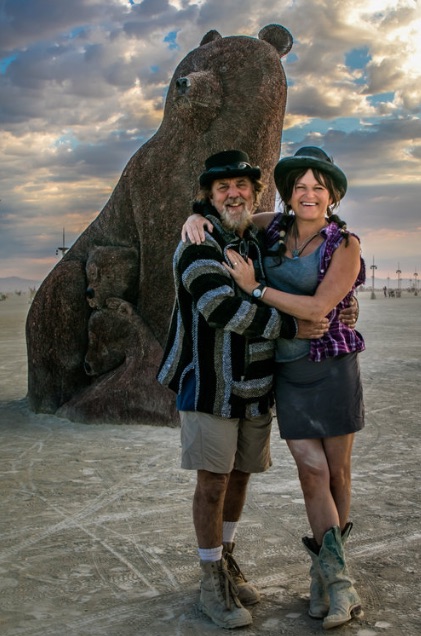
From afar, “Curious” appears to be a furry bear, but as people are drawn to it, they will find that the fur has depth – that it is made of pennies. One can’t help but be curious and wonder how the 250,000 coins got there and how they can give the impression of fur. “Curious” will tower over participants but will not be antagonistic; the bear wants to meet them. It will be a moment when the curious meets the curious. The first bear installation Mr. and Mrs. Ferguson created was Ursa Major, a 14-foot tall bear reaching for the stars. It was created with over 170,000 pennies and was part of the Smithsonian American Art Museum’s Burning Man exhibition “No Spectators — The Art Of Burning Man,” a cooperative venture with Washington’s Golden Triangle Business District.
Robert Ferguson has been welding since he was in high school. After a career in radio broadcasting and river raft tourism, Robert was brought into the family business in 1986 and took it over from his father in 2009. Ferguson Welding specializes in field welding and shop fabrication. Its clientele include most water districts in the San Francisco Bay Area, Tesla and other companies who need fabrication and repair work. Robert and Ferguson Welding have an honored tradition of completing work on time and on budget.
Lisa or Mrs Ferguson is a cinematographer with over 33 years’ experience. She has shot documentaries and lifestyle shows for most major TV and cable networks and has travelled the world several times for them. She has shot and produced the videos on our website about our art projects plus all the photography on our website. Lisa also assists at Ferguson Welding in administration.
Michael Szivos, SoftLab — “Halo”
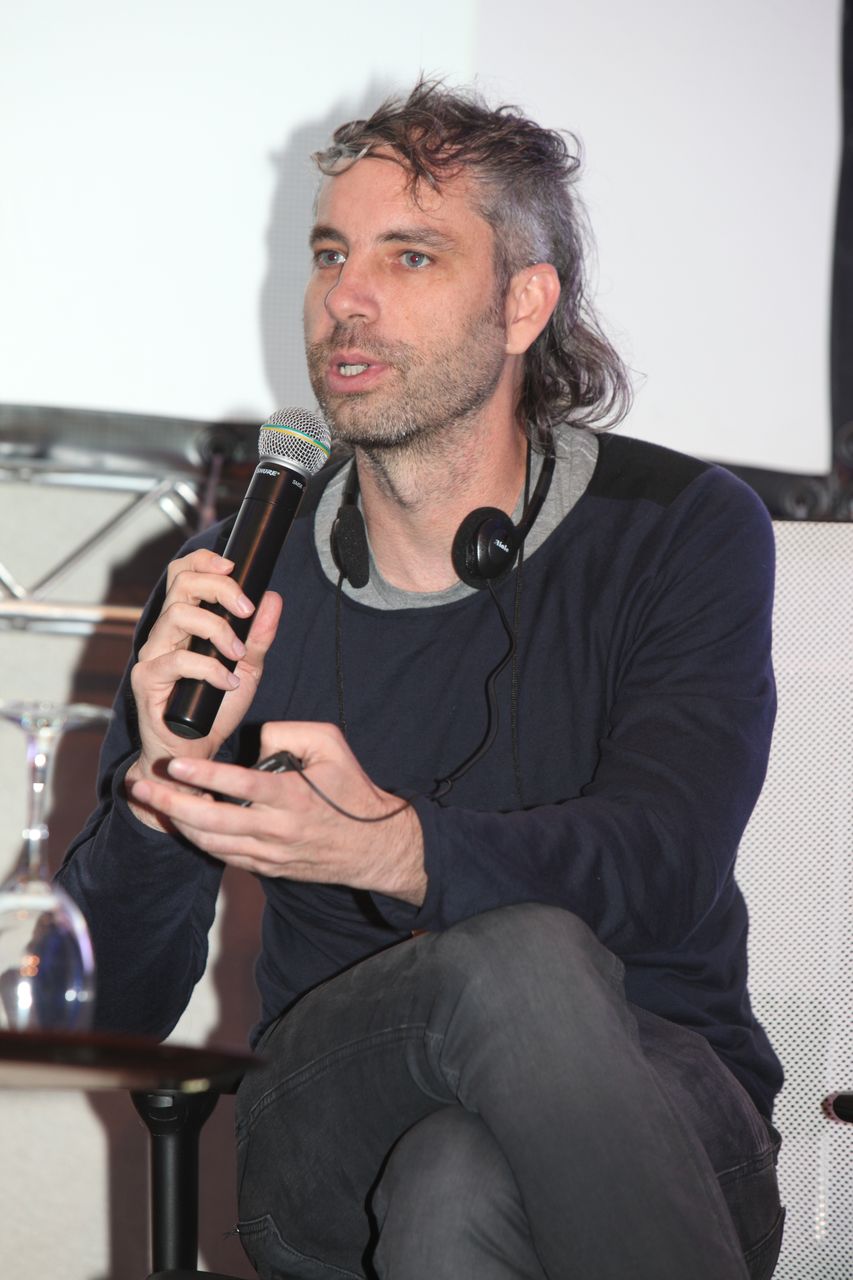
Halo takes the shape of a cylinder that at first glance appears the same from all directions, while at a pedestrian level it has multiple gateways giving the space it creates multiple orientations. The interior space framed by Halo is a place to reflect, meet, have a friendly exchange, or simply pass through. The outside of the cylinder is clad in vertical aluminum tubes that give the exterior a monolithic appearance. The interior is clad in a crystalline structure made of acrylic laminated with 3M dichroic film, which changes color and reflectivity as people move around. The kaleidoscopic effect, and how it will filter both sunlight and light from interactive LEDs in the aluminum tubes, is meant to act as a surprise as visitors enter the space formed by the piece.
The name Halo is inspired by the optical phenomenon that typically happens around the sun as light interacts with ice crystals in the atmosphere. Halo’s form, materials, and how they come together to create space and filter light is a contemporary interpretation of this natural occurrence.
SOFTlab is a design studio based in New York City. The studio was created by Michael Szivos shortly after receiving a graduate degree in architecture from the Graduate School of Architecture, Planning and Preservation at Columbia University. The studio has since been involved in the design and production of projects across almost every medium, from digitally fabricated large-scale sculpture, to interactive design, to immersive digital video installations. As the studio adjusted to a wide range of projects, we began to focus less on the medium and style and more on ideas.
As a studio, SOFTlab, embraces projects through a mix of research and ideas. In 2012 SOFTlab was awarded the Architectural League Prize for Young Architects & Designers and previously in 2010 the studio was selected for the New Practices New York award by the AIA Chapter of New York along with seven other young studios.
The studio has also produced a wide range of design projects and collaborated with various artists, designers, publications and institutions including MoMA, The Metropolitan Museum of Art, The New Museum, The New York Times, eVolo Magazine, Surface Magazine, Columbia University and Pratt Institute. The studio has also exhibited work in galleries throughout New York City.
Hou & DeSousa — “Go”
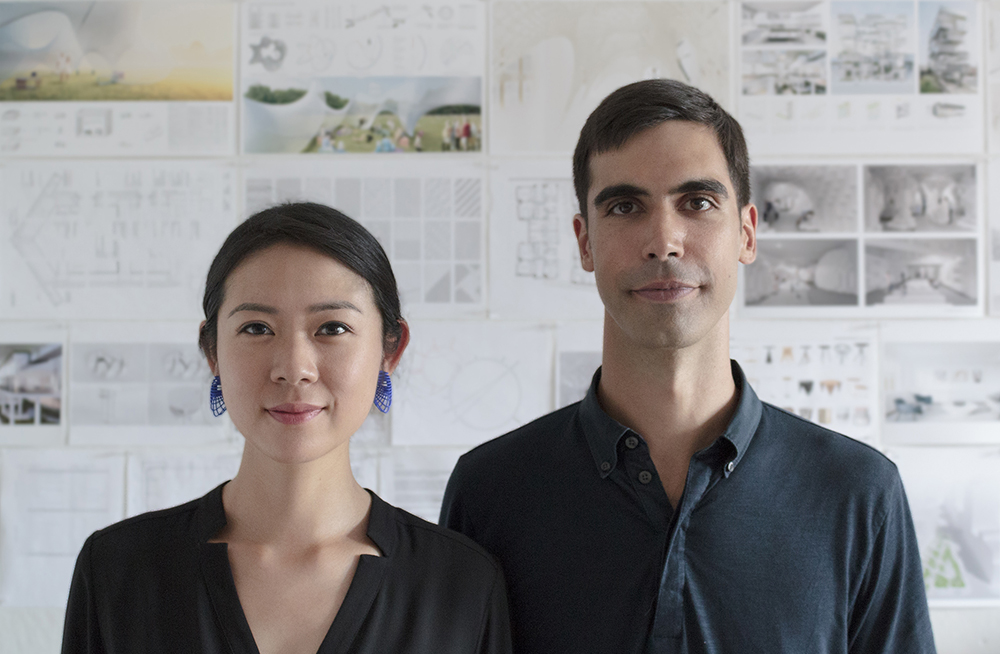
“Go” is a no-tech tactile display system that allows visitors to compose large-scale images and text by manually flipping double-sided discs. Each pixel features a binary composition of white marble and naturally weatherproof charred lumber, typically referred to as shou sugi ban. Each marble face features an engraved question, encouraging visitors to further explore the contents of the pavilion and contemplate queries that are either cosmically profound, trivial, or just plain silly.
The array of discs is collectively supported by a steel lattice structure that has been shaped to resemble a dew drop, or a stone used in the game of Go. This ellipsoidal form is further altered by chopping away a flat base and two entrances, resulting in an enclosed space that also acts as a gateway. Furthermore, this form is well suited to the landscaping of the site, as well as the distinctive undulating roofscape and elliptical clerestories of the new Google Charleston East building.
In addition to providing a piece of public art, the project serves as a gathering place. An additional benefit to the dynamic porous shell, is that visitors can walk around the exterior of the piece and experience a continuously shifting sculptural object or enter into its enclosed space without being visually isolated from the “outside”.
“Go” provides a fun interactive addition to the Google campus that addresses a body of concepts, allusions, and contextual conditions, while simultaneously providing a physical platform for creative expression that resists static meaning, and can be continuously reinterpreted and redefined. In short, “Go” is an art machine, powered by the public.
Founded by Nancy Hou and Josh de Sousa, Hou de Sousa is a New York based architecture, art, and design studio that promotes culturally progressive and environmentally responsible projects that foster public interaction and creativity. The “Go Team” also includes Lisa Ramsburg, Tim Michiels and Powell Draper from Schlaich Bergermann Partner (SBP), an international structural engineering firm with an emphasis on collaborative design and lightweight structures, and Edward Segal, an assistant Professor in the Department of Engineering at Hofstra University, whose work focuses on material exploration, form generation, and historic analysis.
Zachary Coffin — “Rockspinner”
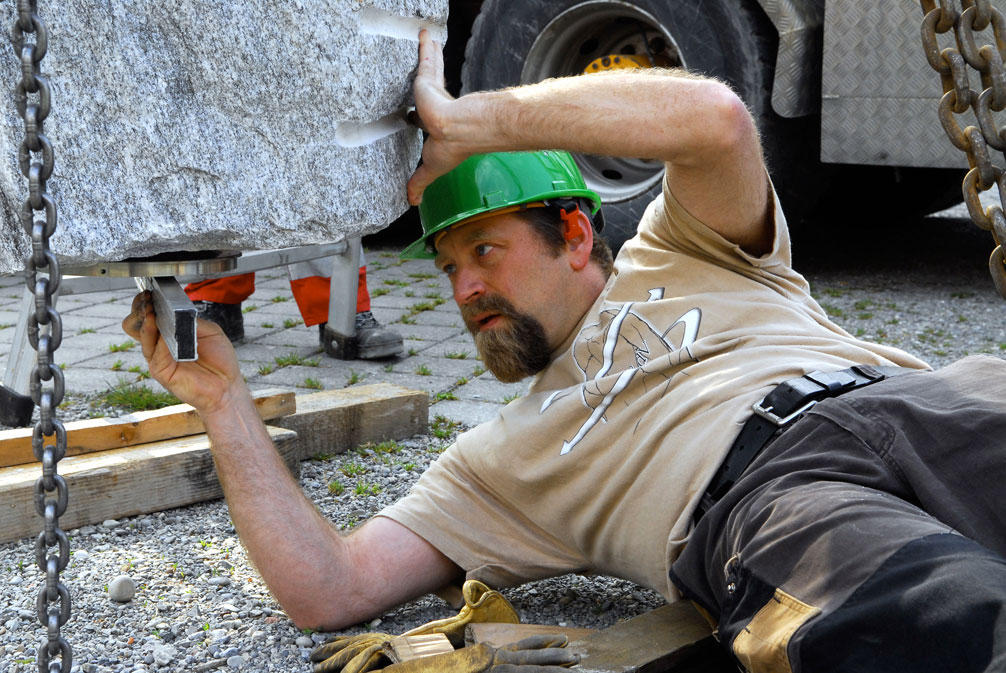
In 2001, Zachary Coffin built an unprecedented work for Burning Man called “Rockspinner.” He extracted a huge boulder from the nearby mountain range and, using a specialized lifting rig, mounted the rock on a bearing — balanced just so that you could spin the rock with ease.
The concept was simple yet sublime: you (or you and your friends — new and old) could spin a giant rock weighing 22,000 pounds. This interactive piece was fun, inspiring, and empowering for participants of all ages and backgrounds!
Inspired by this original piece, he developed this concept into a series of sculptures. Each Rockspinner is a natural, multi-ton boulder, which can be spun easily and silently, compelling viewers to interact and explore while creating a sense of place and an opportunity for fun.
For this project, Zachary will build a Rockspinner of similar scale with improved bearings and playful, interactive lighting for even more fun.
Zachary Coffin has been building large-scale kinetic and interactive sculpture for over 25 years. His work explores the boundary between art and viewer and the way humans can interact with a large mass in motion. His work draws from engineering and the history of industry for a visual language that is practical and dramatic yet unadorned.
He has received multiple public and private commissions throughout the United States and Europe. He lives in the Bay Area with two kids and is working on multiple projects, large to mega-scale — all explorations of gravity, structure and the human condition.
Julian Voss-Andreae — “Quantum Meditation II”
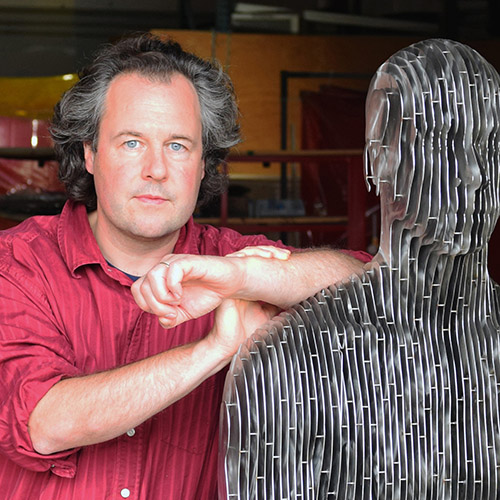
“Quantum Meditation II” is a metaphor for our vastly expanding sense of embodiment as interconnected nodes in a collective cyberspace.
A monumental female figure kneels on the ground, comprised of evenly spaced, parallel slabs of polished stainless steel oriented in the direction of her gaze. When viewed head-on, the sculpture virtually disappears.
The effect is surprising and beautiful and entices people of all ages and backgrounds to interact playfully with the work. The figure has a calm, Buddha-like presence while drawing audiences in with the enigmatic effect the sliced style creates.
Julian Voss-Andreae is a German-American sculptor based in Portland, Oregon. Starting out as a painter, he later changed course and studied physics, mathematics, and philosophy at the universities of Berlin, Edinburgh and Vienna. Voss-Andreae pursued his graduate research in quantum physics, participating in an experiment considered one of the modern milestones of unifying our everyday intuition with the famously bizarre world of quantum physics. He moved to the United States to study sculpture at the Pacific Northwest College of Art and graduated in 2004.
After his graduation, Voss-Andreae began to intertwine his background in science and technology directly into his art. His early sculptural work was inspired by the structure and function of proteins, the building blocks of life. Soon after, Voss-Andreae widened his scope into the realm of figurative sculpture. Seeing the human subject through the lens of science and engineering has allowed him to imagine completely novel and contemporary approaches to the ancient art of figurative sculpture. Directly inspired by quantum physics, Voss-Andreae developed one of his signature styles of sculpture where the human figure has volume and weight when viewed from one angle and almost completely disappears at another. Other novel approaches to figurative sculpture are similarly informed and enabled by cutting-edge technology.
As Voss-Andreae has continued to develop his work in new and exciting ways, multiple institutions, media, collectors, and the public in the United States and abroad have taken notice. His work has been featured in print and broadcast media worldwide and video clips featuring his sculptures have gone viral, with many millions of views, an unusual phenomenon in the field of the visual arts. Recent institutional commissions include large-scale outdoor monuments for Rutgers University, the University of Minnesota, Texas Tech University, and theGeorgia Institute of Technology as well as a number of public works for private developments.
Recently, Voss-Andreae also won the prestigious CodaWorx award for public sculpture.
Top photo: Anchor Artwork by Marc Fornes

